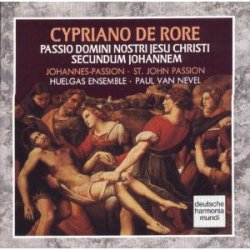Cypriano de Rore - Passio Domini Nostri Jesu Christi Secundum Johannem (1992)
Cypriano de Rore - Passio Domini Nostri Jesu Christi Secundum Johannem (1992)

1. Passio Domini 2. Intermedium I: Ad te levavi oculos 3. Adducunt ergo Jesum 4. Intermedium II: Instrumental 5. Susceperunt autem Jesum 6. Intermedium III: Agnus Dei 7. Judaei ergo quoniam parasceve erat Katelijne van Laethem (cantus), Gilles Ragon (altus), John Dudley (tenor), Josep Cabre (bariton), Lieven Deroo (bassus), Wim Becu (baßposaune), Harry Ries (basßposaune), Willem Bremer (zink, blockflöte), Bart Coen (blockflöte), Renée Stock (Renaissance viola da gamba), René van Laeken (fiedel) Huelgas Ensemble Paul van Nevel – conductor
Cipriano de Rore was an almost purely vocal composer, one of the 'avant gard' madrigalists at the Este Court in Ferrara. This liturgical composition, written sometime around 1555, is an anomaly in Cipriano's oeuvre and in the whole development of the Passion as a musical genre. In it, Cipriano determinedly avoids all the ornamentation and chromaticism that was coming into fashion in Italy with his generation. The Passio Secundum Johannes (Passion according to John) is a gigantic 'trope' on the Gregorian passion plainchant in the Lydian mode, and thus both a brazenly old-fashioned and boldly timeless piece of music. It combines mensural and non-mensural passages, revives the early Renaissance 'falso bordone' bass, and proceeds chiefly homophically, with highly stylized polyphonic cadences. There's a numerical pattern to the 'roles' in the Passion; the words Christ are set in three parts, the Evangelist's text is set in four, the 'turbid' crowd in six, and Pontius Pilate in bicinium. Three polyphonic "intermedia" are inserted between sections of the Passion, a practice fully justified historically.
The whole seems profoundly devotional, both the least flamboyant and most 'spiritual' setting of the Passion text in the whole history of music. That's one reason why I've listened to it rarely; it's too grand a concept to be heard 'lightly'. I can only imagine listening to it when I want and need to sit attentively through the whole performance. The other reason why I seldom listen to this CD is the instrumentation. The use of a panoply of instruments, some of which would not have been permitted in a liturgical setting, is distracting and ineffective. I say so despite the fact that I'm a wind-instrument player myself, and love to play 16th C polyphony in 'closed' (same instrument) consorts. But it is a good performance, despite the wrong-headed instrumentation. The Huelgas Ensemble is like that, consistently inconsistent and often frustrating. If you are passionate, as I am, about the 16th C repertoire, Cipriano de Rore is a composer you will want to hear, and this is a sui generis masterwork. --- Giordano Bruno (Wherever I am, I am.), amazon.com
Cipriano de Rore (1515 or 1516 – 1565) was a Franco-Flemish composer of the Renaissance, active in Italy. Not only was he central representative of the generation of Franco-Flemish composers after Josquin des Prez who went to live and work in Italy, but he was one of the most prominent composers of madrigals in the middle of the 16th century. His experimental, chromatic, and highly expressive style had a decisive influence on the subsequent development of that secular music form.
download: uploaded yandex 4shared mediafire solidfiles mega zalivalka filecloudio nornar anonfiles oboom
Last Updated (Monday, 14 April 2014 23:34)








